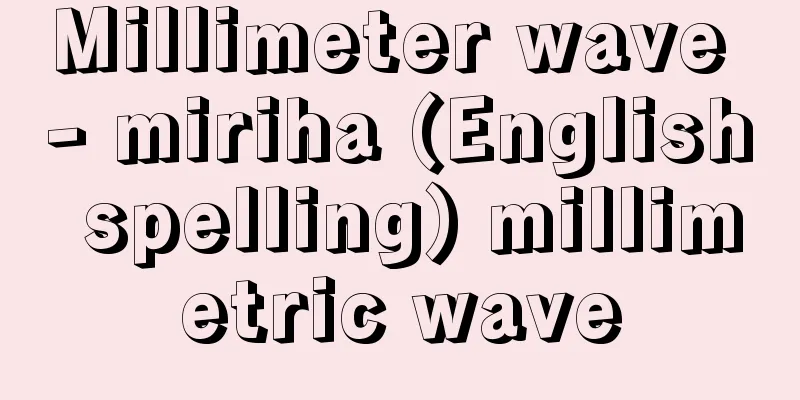Millimeter wave - miriha (English spelling) millimetric wave

|
A classification of radio waves according to wavelength for the convenience of use. It is commonly used to refer to radio waves with wavelengths ranging from 10 millimeters to 1 millimeter and frequencies ranging from 30 gigahertz to 300 gigahertz. It is also called millimeter waves. In terms of the abbreviation for the frequency band stipulated in the Enforcement Regulations of the Radio Law, it corresponds to the EHF band (millimeter waves). EHF radio waves have a higher frequency, allowing for a wider bandwidth than SHF (over 3 GHz, below 30 GHz). However, they cannot be used for long-distance transmission because they are significantly attenuated when passing through rain or fog. For this reason, they are used for relatively short-distance wireless access, image transmission systems, millimeter-wave radar, etc. In remote sensing, they are not used as a communication medium, but rather as infrared observations by earth observation satellites, where the amount of water vapor in space that causes errors in measurements is measured by the attenuation of millimeter waves (around 37 GHz) naturally emitted from the object being observed, and the amount of infrared loss is calculated. Millimeter waves are also used in astronomy (at the Nobeyama Radio Observatory of the National Astronomical Observatory, for example), where weak millimeter waves emitted from celestial bodies and reaching the Earth are received by a giant parabolic antenna (rotating parabolic mirror antenna) to explore the composition of celestial bodies. The 2000 amendment to the Radio Law established a frequency band in the 60 GHz band that could be operated without a license. The millimeter wave band also uses the 50 to 57 GHz and 66 to 95 GHz bands for mobile phone relay base stations, which require large numbers of installations, taking advantage of the property that the wave propagates over a wide bandwidth but only over short distances. The use of frequencies above 100 GHz is not permitted except for special military purposes, and as of 2012, it is not yet possible to use them due to technical and economic reasons. The law specifies even shorter wavelengths, up to decimeter waves (over 300 GHz and below 3000 GHz), but there is no specific name for this frequency band, and it gradually becomes closer to the properties of far-infrared rays, making it difficult to oscillate as radio waves. Furthermore, frequencies higher than this are not legally treated as radio waves. To use the EHF band, an oscillator with a frequency one order of magnitude higher than SHF waves is required. At the lower frequencies within the band, magnetrons and klystrons can be used. [Iwao Ishijima] [Reference] | | | |Source: Shogakukan Encyclopedia Nipponica About Encyclopedia Nipponica Information | Legend |
|
電波を利用上の便宜から波長によって区分したものの一つ。波長の範囲は10ミリメートルから1ミリメートルまでであり、周波数範囲は30ギガヘルツから300ギガヘルツまでの電波を慣用的に総称していう。ミリメートル波ともよばれる。電波法施行規則で定められた周波数帯の略称ではEHF帯(ミリメートル波)に相当する。 EHF帯の電波は周波数が高いことからSHF帯(3ギガヘルツを超え、30ギガヘルツ以下)よりさらに広帯域の使用が可能である。しかし、雨や霧のなかを通過すると大きな減衰を受けるので遠方までの伝送には使用できない。このため比較的短距離の無線アクセス、画像伝送システム、ミリ波レーダーなどに使用される。リモート・センシング(遠隔探査)においては、通信の媒体としてではなく、地球観測衛星による赤外線観測で、測定値に誤差を与える空間に存在する水蒸気量を、観測対象から自然放射されるミリ波(37ギガヘルツ付近)の減衰量によって測定し、赤外線の損失量を算定する。ミリ波はまた、天文学にも応用され(国立天文台野辺山(のべやま)宇宙電波観測所など)、天体から放射され地球に到達する微弱なミリ波を巨大なパラボラアンテナ(回転放物鏡アンテナ)で受信して、天体の組成まで探査する。 2000年(平成12)の電波法改正により、60ギガヘルツ帯に無免許で運用できる周波数帯が設けられた。またミリ波の帯域は、近距離ではあるが広帯域に伝播(でんぱ)する性質を利用して、多数設置を必要とする携帯電話中継基地局用として、50ギガから57ギガヘルツおよび66ギガから95ギガヘルツまで使用されている。100ギガヘルツを超える周波数の使用は特殊な軍事目的以外には行われておらず、2012年時点では技術面、経済面ではまだ利用できていない。 法律のうえではさらに波長の短いデシミリメートル波(300ギガヘルツを超え、3000ギガヘルツ以下)までを定めているが、周波数帯としての呼び名もなく、しだいに遠赤外線の性質にも近づくため、電波としての発振は困難になってくる。また、それ以上の周波数は法的にも電波として扱わない。 EHF帯の利用には、SHF波よりも1桁(けた)上の周波数の発振器が必要となる。帯域内の低い周波数部分においては、マグネトロン(磁電管)やクライストロン(速度変調管)が使用可能である。 [石島 巖] [参照項目] | | | |出典 小学館 日本大百科全書(ニッポニカ)日本大百科全書(ニッポニカ)について 情報 | 凡例 |
<<: Millimetric wave communication
Recommend
Cooking table - Kansho
…On the other hand, the “hu fu” (bed) seen in Han...
Electrolytic polarization
The phenomenon in which the voltage U between the ...
Fujio Egami
Biochemist. Born in Tokyo on November 21, 1910. G...
Disaster Prevention - Bousai
There are various types of disasters, from those ...
Katakura Group
…Founder of the Katakura Group. Born as the eldes...
Multi-headed stone axe - Tatsusekifu
A type of polished stone axe used for club heads ...
Stuparich, C. (English spelling)
...The Trieste Regionalist writers, who belonged ...
Ape-Man Cave - Enjindo
…A fossil human discovered at Site 1 of the Zhouk...
Kiriwina [island] - Kiriwina
…The name of the island comes from the name of an...
Pulmonary mycosis
Pulmonary mycosis is a deep-seated mycosis caused ...
Rejected - Kyakka
Generally speaking, it refers to a disposition th...
common ash
...It grows in pure forests on fertile land near ...
Guji - Guji
…The famous Okitsu sea bream is from Suruga Bay a...
Calvin Cycle - Calvin Cycle
The reduced pentose phosphate cycle, also known as...
Unemeden
〘 noun 〙 Under the ritsuryo system, fields were pr...









